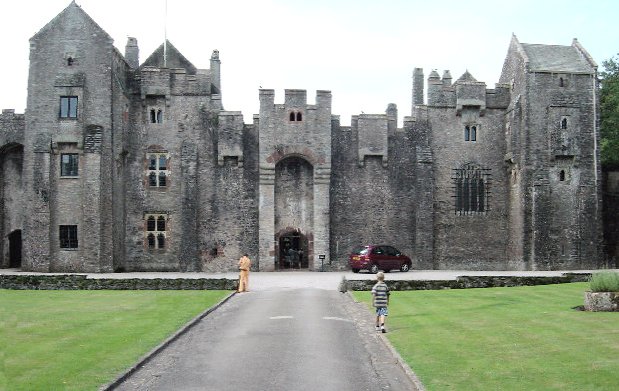I read Daphne Du Maurier’s Rebecca for the first time this
year during lockdown. I wasn’t sure what
to expect, but I found it to be one of the most amazing stories ever
written. Inevitably, such a famous novel
found its way to the big and small screen, most famously in 1940 with Laurence
Olivier playing the tragic Mr de Winter and Joan Fontaine playing his socially
awkward second wife, struggling to step into the footsteps of the first Mrs de
Winter, the Rebecca of the title. Shortly after I read the novel I learned that
a new version was to be released, with Armie Hammer playing opposite Lily
James, and with Kristin Scott Thomas as the forbidding head housekeeper
Danvers.
I rushed to watch this new version, in anticipation of
seeing some familiar scenes from my native Cornwall, However, it turns out that just about
anywhere other than Cornwall was used for the locations (at least the film used
UK locations, unlike the 1940 version, which was largely filmed in
California).
As in the original, the film kicks off in the South of
France, but the hotel suite occupied by the dreadful Mrs Van Hopper and the
“new Mrs de Winter-to-be” is not in France at all, but was filmed at Waddesdon Manor in Buckinghamshire, which has a suitably chateau-like appearance. The Manor was built by Baron Ferdinand de
Rothschild in 1877 as a summer bolt-hole for entertaining.
Waddesdonterrace. Photo by Giano, via
Wikimedia Commons.
The first glimpse of Manderley as the newly weds drive up to
the property was filmed at Cranborne Manor, midway between Wimborne Minster and
Salisbury. The great entrance hall where
the couple are greeted by the servants was filmed at Hatfield House, Hertfordshire,
which was also used for a pivotal point in the story when Mrs de Winter mark 2
is tricked into choosing an ill-advised costume for the summer ball she and Max
are hosting at Manderley. The painting
which provides the inspiration for the outfit is in real life a portrait of Mrs
Hugh Hammersley, which is to be found in Hatfield House. The Persian rugs and wood panelled walls seen
in the interior scenes were also from Hatfield.
Cranborne Manor - geograph.org.uk - 1223951. Photo by Mike Searle, via Wikimedia Commons.
As Mrs de Winter is seen exploring
Manderley, there are many works of art in view.
Some of these are from the interior of Petworth House, West Sussex,
which was used for some of the scenes. Meanwhile,
for Rebecca’s wing of Manderley, which has been kept as a shrine to her by
Danvers, we are transported to Dorset, to Mapperton House, which is also where
the accident with the precious porcelain was filmed. The East Wing bedrooms, however, are from
Loseley House near Guildford.
In the ‘downstairs’ part of Manderley, where the servants
hang out, we see the basement kitchen and the corridors leading to and from
it. The kitchen area of Osterley House
in the London Borough of Hounslow was used for these scenes, with some crockery
and food items added in to complete the scene.
Osterley House also provided the stables for the scene in which Mrs de
Winter was persuaded to try her hand at horse riding by Rebecca’s cousin, Jack
Favell (Sam Riley).
Osterley Park 800. Photo by Sannse, via Wikimedia Commons.
For me, the biggest disappointment of the filming locations,
given the gorgeousness of the Cornish coast, is that the coastal scenes were
filmed outside the county, specifically at Hartland Quay, North Devon,
recognisable from its unusual rock formations.
Hartland Quay - panoramio (3). Photo by Matt Prosser, via Wikimedia Commons.
Waddesdon Manor is about five miles north-west of Aylesbury
and is open to visitors, with advance booking only during the coronavirus
pandemic. The beautiful grounds include
an aviary housing a range of exotic birds.
The house is a repository for an extensive collection of art, in
particular 18th century French pieces, this being a favourite period
of the Rothschilds.
Cranborne Manor, just outside the village of Cranborne, is
notable for its gardens, originally from a design by John Tradescant in the 17th
century and rediscovered in the 19th century, then replanted in the
Arts and Crafts style a century later. Visitors
to the gardens also have access to a cafe and a shop. Hatfield House, dating from 1611 and owned by
the Cecil family for 400 years, has been used extensively in filming. The house and gardens are open to visitors
except for the winter season, when only the park and woodland walks, the cafe
and shops are open.
Petworth House is on the edge of the small town of Petworth,
West Sussex. This vast 17th
century house and its grounds are run by the National Trust. Works of art on display in the state rooms
include paintings by Van Dyck, Turner, Reynolds and Gainsborough. Mapperton House is near Beaminster in Dorset
and is the home of the Earl and Countess of Sandwich. Both the house and gardens are open to
visitors. Loseley Park lies just beyond
the southern edge of Guildford, Surrey.
The gardens are open to visitors in the summer, and the property is also
available for weddings. In normal,
non-covid, times the house can be visited on guided tours.
Osterley Park and House, run by the National Trust, lies
between the M4 and the Great West Road just a few miles east of Heathrow
Airport. The house is in the
neo-classical style, designed by Robert Adam and is surrounded by landscaped
parklands and gardens. Hartland Quay is
at the western extreme of the North Devon coast, known for its rough seas
during the winter months, which have been responsible for many shipwrecks over
the years. The distinctive layered rocks
seen in the film are sedimentary rocks deposited during the Carboniferous
period.
.jpg)





















